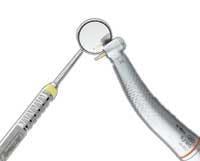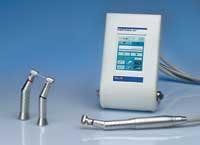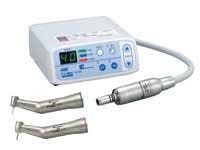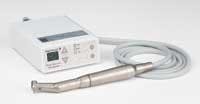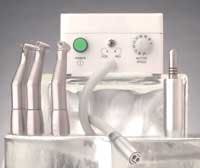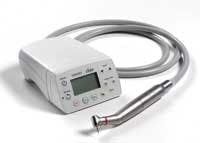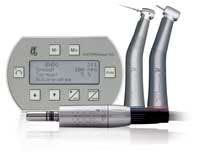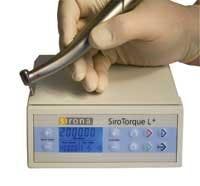by Dr. Joe Blaes, Editor
One of the most important changes to my practice in the past 10 years has been my electric handpiece. It has allowed me to do better dentistry for my patients. My tooth preparations are more precise and done with less noise and vibration. With the latest versions of electric motors and handpieces, the noise level has become less and less. This low level of sound is a great benefit to the dental team members’ ears. I predict that the dental team of the future will no longer suffer hearing loss due to high-pitched handpieces.
Speed and torque
With my electric handpiece, I have bur speeds that are variable from 84 to 200,000 RPMs, which translates to up to 60 watts of cutting power at the bur. The air-driven handpiece running at top speed produces less than 20 watts. With this power, you will experience - for the first time - a constant torque that will not slow down when you apply pressure. Even at lower speeds, you still have ample torque to make precise margins. So, the only thing you have to learn is how to retrain yourself to forget the “feather prep”!
With an electric motor driving the handpiece, you simply put the bur on the tooth and cut it with an ease that you have never experienced before. I found that I was able to cut teeth faster, with less stress both physically and mentally. But, this is not just about speed!
I always thought my tooth preparations were great, but now they are even better. Constant torque gives me more control over the bur. I suddenly noticed that my preparations were more precise, and my dentistry had reached a level that I never thought possible. Even my lab noticed the difference! David Block, owner of Aesthetic Porcelain Studios - (800) 544-9605 - called to ask what I was doing differently. David had always told me that I had the best preps he had ever seen, but now I was on a new level. The only thing I was doing differently was using the electric handpiece.
Forget bur chatter
For years, we have all had to deal with bur chatter, especially when cutting through different types of metal and cutting cast crowns. Have you ever experienced this chatter in your own mouth? I can tell you from my own experience that it is not pleasant at all. When I had a gold crown removed, I realized the sensations I was feeling were the same ones my patients feel when I do this procedure with my air-driven handpiece. I remember thinking there must be a better way! Chatter is caused by bur wobble, which is caused by ball bearing wear in the air turbine, which is supported by O-rings. The older the bearings, the more the bur can wobble.
The electric handpiece provides greater bur concentricity because electrics rely on solid gear-to-gear contact and rigid bearing support. Therefore, the bur does not wobble, and chatter is eliminated. This results in a truer, more definite cutting instrument, which allows you to routinely produce more precise margins faster with much less effort. In addition, the bur is in contact with the tooth for a shorter time, which means that less heat is produced, leading to less sensitivity. This function of the electric handpiece is referred to as “milling,” as opposed to “chopping” the tooth. The result is a tooth preparation that has smoother walls and more precise margins in less time and with less stress for the dentist and patient. Your patients will love spending less time in the chair!
Patient comfort
There are other advantages for the patient as well. First, if I am doing better preps, they are getting better dentistry! But they will notice other things first, such as less of that irritating whine. It isn’t totally eliminated, but noise is reduced by about 65 percent. They will notice no vibration because, unlike air rotors, electric handpieces use a gear-driven head design that consistently maintains 90 degrees between the bearings and shaft. This design makes the bur concentric. Patients notice their time in the chair is reduced because I am more efficient. I have yet to have a patient complain about spending less time in the chair! Gosh, if you are more efficient, maybe you could produce more in less time and free up some extra time for more production or perhaps more time for yourself and your family.
But aren’t they “heavy”?
A common complaint from dentists of both genders is that the electric handpiece is too heavy, too cumbersome. I have found that it is all a matter of balance and concentration. If you learn to balance the electric motor in the area between your thumb and index finger, you will find that weight is no longer an issue. I know many times I get impatient and am unwilling to break through the learning curves to master a new technique. But when I persevered, I became the winner as well as a better dentist. I have watched dentists struggle with the electric handpiece in an exhibit booth. I hand them a tooth and ask them to cut an ideal Class II prep or crown prep. When they are finished, I ask if the handpiece was heavy and, invariably, they say no. In other words, the weight of the handpiece is more of a “head” issue - an issue of perception.
Cut with it
Visit a booth at a dental show to look at an electric handpiece. The only way to confirm everything I have told you is to try it. Usually, there is a piece of bone or a tooth to cut on as part of the booth display. Ask for a new diamond, pick up the bone, and sink the bur about a quarter of an inch (6.5 mm) into the bone, and then move it as quickly as you can in different directions. I usually write my name, so if you find “Joe” in the bone, you’ll know I was there. If you are given a tooth, try a crown prep, but instead of shaving the tooth, sink the bur into the enamel about a millimeter and continue around the tooth at that level. Really give the electric handpiece a good trial while you are at the booth.
In no particular order, here are some electric handpieces to try out. This list is certainly not intended to be complete. These are electric handpieces that I have tried and liked, or electrics that other dentists have tried and told me they liked. So, it is a biased listing.
A-dec:
Introduced at the ADA meeting in San Francisco, this electric handpiece has the smallest head in the industry and five spray ports. Check out the A-dec/W&HSynea WA-99LT.
Bien Air:
I have had this electric the longest, so I have the most experience with it. Be sure to look at the new MX system which is the only complete solution. The OPTIMA MX is the external version that simply connects to your standard 4-hole tubing. The DIGIPAD MX is the internal version for seamless integration that allows you to use two motors on the same unit.
Brasseler USA/NSK NL400 Brushless Electric System:
Even though I have not personally tried this handpiece, I have heard other dentists report that they are very pleased with the performance and the weight of the handpiece.
DentalEZ Star Dental Titan E-lectric Motor System:
I have not used this system in the mouth, but have tried it at a dental meeting. I have heard some good comments at my seminars. Be sure to check it out. Star Dental is a great name in handpieces.
Lares Apex Electric:
I have not used this handpiece, but have heard some good comments. Be sure to check it out. Lares is another great name in handpieces.
DENTSPLY Midwest eStylus:
I have tried the high-speed handpiece and found that it did a good job of cutting teeth. I did not try any of the attachments. Be sure to check it out. Midwest is a great name in handpieces.
KaVo:
I have been using this electric for about five years with great success and no breakdowns or repairs. In most dentists’ minds, KaVo tends to be the “king of the handpieces.” Be sure to see their new ELECTROtorque TLC (Torque Limit Control) system.
Sirona SIROTorque L+:
I have been using this handpiece for more than three years with great success and no breakdowns or repairs. This handpiece is unique in that it covers the electric motor. It is lightweight and balances well, so it could be a good choice for a woman dentist. Be sure to see the T1 Classic.

